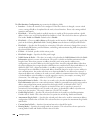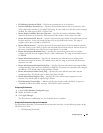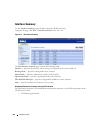
560 Configuring IPv6
The IPv6 Interface Configuration page contains the following fields:
•
Interface
— Selects the interface to be configured. When the selection is changed, a screen refresh
occurs, causing all fields to be updated for the newly selected interface. Shows only routing-enabled
interfaces and tunnels.
•
IPv6 Mode
— When IPv6 mode is enabled, interface is capable of IPv6 operation without a global
address. In this case, an EUI-64 based link-local address is used. This selector lists the two options for
IPv6 mode:
Enable
and
Disable
. Default value is
Disable
.
•
IPv6 Prefix
— Choose to
Add
or
Delete
an IPv6 prefix on this interface. If adding a prefix, specify that
prefix in the following
IPv6 Prefix
field. Checking
Delete
causes deletion of a displayed IPv6 Prefix.
•
IPv6 Prefix
— Specifies the IPv6 prefix for an interface. When the selection is changed, the screen is
refreshed and valid lifetime, preferred lifetime, on-link flag, and autonomous flag fields are updated for
the selected IPv6 address.
•
EUI-64
— If checked, specifies 64-bit unicast prefix.
•
IPv6 Prefix Length
— Specifies the IPv6 prefix length.
•
Va li d L ifeti me by Prefix
— The value, in seconds, to be placed in the
Valid Lif etime
field of the
Prefix
Information
option in a router advertisement. The prefix is valid for on-link determination for this
length of time. Hosts that generate an address from this prefix using stateless address auto-
configuration can use those addresses for this length of time. An auto-configured address older than
the preferred lifetime but younger than the valid lifetime are considered to be deprecated addresses. As
defined by RFC 2462, a deprecated address is an address assigned to an interface whose use is
discouraged, but not forbidden. A deprecated address should no longer be used as a source address in
new communications, but packets sent from or to deprecated addresses are delivered as expected. A
deprecated address may continue to be used as a source address in communications where switching to
a preferred address causes hardship to a specific upper-layer activity (for example, an existing TCP
connection). The valid range is from 0 to 4,294,967,295 seconds.
•
Preferred Lifetime by Prefix
— The value, in seconds, to be placed in the
Preferred Lifetime
in the
Prefix Information
option in a router advertisement. Addresses generated from a prefix using stateless
address autoconfiguration remain preferred for this length of time. As defined by RFC 2462, a
preferred address is “an address assigned to an interface whose use by upper layer protocols is
unrestricted. Preferred addresses may be used as the source (or destination) address of packets sent
from (or to) the interface.” The range is from 0 to 4,294,967,295 seconds.
•
Onlink Flag by Prefix
— Specifies the selected prefix that can be used for on-link determination.
Default value is Enable. This selector lists the two options for on-link flag: Enable and Disable.
•
Autonomous Flag by Prefix
— Specifies the selected prefix that can be used for autonomous address
configuration. Default value is Disable. This selector lists the two options for autonomous flag: Enable
and Disable.
•
Current State by Prefix
— Interface Operational status for selected IPv6 prefix.
•
Routing Mode
— Specifies the routing mode of an interface. This selector lists the two options for
routing mode: Enable and Disable. Default value is Disable.


















